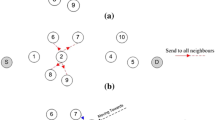Abstract
In this paper we discuss how we improved the MChannel group communication middleware for Mobile Ad-hoc Networks (MANETs) in order to let it become both delay- and energy-aware. MChannel makes use of the Optimized Link State Routing (OLSR) protocol, which is natively based on a simple hop-count metric for the route selection process. Based on such metric, OLSR exploits Dijkstra’s algorithm to find optimal paths across the network. We added a new module to MChannel, enabling unicast routing based on two alternative metrics, namely end-to-end delay and overall network lifetime. With such new module, we prove that network lifetime and average end-to-end delay improve, compared to the original OLSR protocol implementation included in the mentioned middleware. Thanks to MChannel’s approach, which implements routing in the user’s space, the improvements achieved in the unicast jOLSR routing protocol are transparently applied to the upstanding MChannel overlay multicast OMOLSR protocol. We also discuss how the proposed new module actually represents a general framework which can be used by programmers to introduce in MChannel novel metrics and path selection algorithms.














Similar content being viewed by others
References
Anathan R, Redi J (2002) A brief overview of ad hoc networks: challenges and directions. IEEE Communications Magazine, 50th Anniversary Commemorative issue, pp 20–22
Conti M, Giordano S, Maselli G, Turi G (2004) Cross-layering in mobile ad hoc network design. IEEE Computer, Special Issue on Ad Hoc Networks
Lopez PG, Tinedoa RG, Alsina JMB (2010) Moving routing protocols to the user space in MANET middleware. J Netw Comput Appl 33(5):588–602 (Middleware Trends for Network Applications)
Lin X, Shroff NB, Member S, Srikant R (2006) A tutorial on cross-layer optimization in wireless networks. IEEE J Sel Areas Commun 24:1452–1463
Meghanathan N (2009) Survey and taxonomy of unicast routing protocols for mobile ad hoc, vol 1(1). The international journal on applications of Graph Theory in Wireless Ad hoc Networks and Sensor Networks (GRAPHHOC). Jackson State University, Jackson, MS, USA
Mahapatra P, Li J, Gui C (2003) QoS in mobile ad hoc networks. IEEE Wirel Commun 10(3):44–52
Toh C-K (2001) Maximum battery life routing to support ubiquitous mobile computing in wireless ad hoc networks. IEEE Commun Mag 39(6):138–147
Mahfoudh S, Minet P (2008) Survey of energy efficient strategies in wireless ad hoc and sensor networks. In: IEEE international conference on networking. Cancun, Mexico, pp 1–7
De Rango F, Fortino M (2009) Energy efficient OLSR performance evaluation under energy aware metrics. In: Symposium on performance evaluation of computer and telecommunication systems, pp 193–198
Kim D, Garçia Luna Aceves JJ, Obraczka K, Cano J, Manzoni P (2002) Power-aware routing based on the energy drain rate for mobile ad hoc networks. In: Proceedings of IEEE 11th international conference on computer communications and networks, pp 562–569
Perkins CE, Belding-Royer E (2001) Quality of service for ad hoc on-demand distance vector routing. Mobile Ad Hoc Networking Working Group, Internet Draft (expired on January 2001)
Lee S, Gerla M (2001) Split multipath routing with maximally disjoint paths in ad hoc networks. In: Proceedings of IEEE ICC
Sondi P, Gantsou D (2009) Voice communication over mobile ad hoc networks: evaluation of a QoS extension of OLSR using OPNET. In: Proceedings of AINTEC’09, Bangkok
Badis H, Munaretto A, Agha KA, Pujolle G (2003) Qos for ad hoc networking based on multiple-metric: Bandwidth and delay. In: IFIP/IEEE international conference on mobile and wireless communications networks
Badis H, Al Agha K (2005) QOLSR, QoS routing for ad hoc wireless networks using OLSR. Eur Trans Telecommun 16:427–442. doi:10.1002/ett.1067
Mahfoudh S, Minet P (2008) An energy efficient routing based on OLSR in wireless ad hoc and sensor networks. In: Proceedings of the 22nd international conference on advanced information networking and applications—workshops (AINAW ’08). IEEE Computer Society, Washington, DC, pp 1253–1259. doi:10.1109/WAINA.2008.60
Jaffrès-Runser K, Schurgot M, Comaniciu C, Gorce JM (2010) A multiobjective performance evaluation framework for routing in wireless ad hoc networks. In: IEEE 8th international symposium on modeling and optimization in mobile, ad hoc, and wireless networks (WiOpt)
Marwaha S, Srinivasan D, Tham CK, Vasilakos A (2004) Evolutionary fuzzy multi-objective routing for wireless mobile ad hoc networks. In: Proceedings of the IEEE Congress on Evolutionary Computation (CEC2004), vol 2, pp 1964–1971
Montana D, Redi J (2005) Optimizing parameters of a mobile ad hoc network protocol with a genetic algorithm. In: Proceedings of the 2005 conference on Genetic and Evolutionary Computation (GECCO ’05), pp 1993–1998
Sarangapani J (2007) Wireless ad hoc and sensor networks: protocols, performance, and control. Control Engineering Series
Asokan R, Natarajan AM (2008) An approach for reducing the end to end delay and increasing the network lifetime in mobile ad hoc networks. Int J Inf Technol 4(2):121–127
Asokan R, Natarajan AM (2008) Performance evaluation of energy and delay aware Quality of Service (QoS) routing protocols in mobile adhoc networks. International Journal of Business Data Communications and Networking 4(2)
Li Q, Aslam J, Rus D (2001) Online power-aware routing in wireless ad-hoc networks. In: Proceedings of the 7th annual international conference on mobile computing and networking (MobiCom ’01). ACM, New York, pp 97–107. doi:10.1145/381677.381687
Author information
Authors and Affiliations
Corresponding author
Rights and permissions
About this article
Cite this article
Costagliola, N., López, P.G., Oliviero, F. et al. Energy- and Delay-Efficient Routing in Mobile Ad Hoc Networks. Mobile Netw Appl 17, 281–297 (2012). https://doi.org/10.1007/s11036-011-0335-1
Published:
Issue Date:
DOI: https://doi.org/10.1007/s11036-011-0335-1




